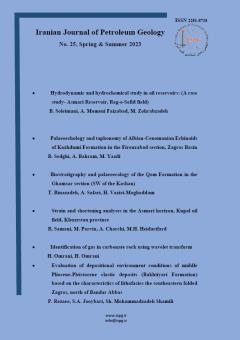تحلیل کرنش و كوتاه شدگي در افق آسماری، میدان نفتی کوپال، استان خوزستان
الموضوعات : Geoscience Fields in relation with Petroleum Geologyبابک سامانی 1 , مینا پروین 2 , عباس چرچی 3 , محمد حسین حیدری فرد 4
1 - دانشکده علوم زمین دانشگاه شهید چمران اهواز
2 - گروه زمینشناسی، دانشكده علوم زمين، دانشگاه شهید چمران اهواز، اهواز، ايران
3 - گروه زمین شناسی، دانشکده علوم زمین دانشگاه شهید چمران اهواز
4 - شرکت ملی مناطق نفت خیز جنوب، اهواز، ایران
الکلمات المفتاحية: فروافتادگی دزفول, میدان نفتی کوپال, نسبت ابعادی چین, نسبت کرنش, کوتاه شدگی,
ملخص المقالة :
میدان نفتی کوپال یکی از میدان های نفتی مهم در حوضه زاگرس است، که در بخش خاوری منطقه ساختاری فروافتادگی دزفول، در مجاورت میدان نفتی آغاجاری و میدان نفتی مارون قرار دارد. با استفاده از مقاطع لرزه¬ای تفسیر شده و بررسی سیمای چین خورده افق آسماری، برخی ویژگیهای عناصر چین، همچون مقادیر زاویه بین یالی و خصوصیات سطح محوری تعیین گردید. براساس میزان انحراف سطح محوری از سطح قائم و تعیین مقادیر زاویه برش و کرنش برشی، مقادیر مربع کشیدگی حداقل و حداکثر و نسبت کرنش (R) در بخش های مختلف تاقدیس محاسبه گردید. با استفاده از توابع تصویری مقادیر نسبت ابعادی چین در بخش¬های مختلف تاقدیس تعیین گردید. براساس نتایج، مقادیر کرنش برشی از 01/0 تا 09/0 در بخش های مختلف تاقدیس متغییر است. همچنین نتایج نشان دهنده دامنه تغییرات نسبت کرنش در محدوده 25/1 تا 38/1 و مقادیر کوتاه¬شدگی بین 5 تا 17 درصد در بخش¬های مختلف تاقدیس می¬باشد.
[1] ALAVI, M., 1994, Tectonics of the Zagros orogenic belt of Iran: new data and interpretation. Tectonophysics, 229, 211–238.
[2] ALAVI, M., 2004, Regional stratigraphy of the Zagros fold-thrust belt of Iran, and its proforeland evolution. American Journal of Science 304, 1–20.
[3] ALAVI, M., 2007, Structures of the Zagros fold-thrust belt in Iran. American journal of science, vol. 307, 1064-1095.
[4] AL-AZZAWI N. K. 2008, Local Shortening of Folds and Detachment Surface Depth with Examples from the Foreland Belt of Iraq. Iraqi Journal of Earth Sciences- Vol. 8. No. 1- May
[5] BERBERIAN, M., 1995, Master ‘blind’ thrust faults hidden under the Zagros folds: active basement tectonics and surface morphotectonics, Tectonophysics, 241, 193–224.
[6] BERBERIAN, M., KING, G.C.P., 1981, Towards a paleogeography and tectonic evolution of Iran. Canadian Journal of Earth Sciences 18, 210–265.
[7] BLANCE, E.J.P., ALLEN, M.B., INGER, S., HASSANI, H., 2003, Structural styles in the Zagros Simple Folded Zone, Iran. J. Geol. Soc. 160, 401–412. doi:10.1144/0016-764902-110.
[8] BROWN, D., ALVAREZ - MARRON, J., PEREZ - ESTAFIN, A., GOROZJANIN, Y., BARYSHEVA, V., PUCHKOV, V., 1997, Geometric and kinematic evolution of the foreland thrust and fold belt in the southern Urals. Tectonics, VOL. 16, NO. 3, PAGES 551-562, JUNE 1997.
[9] ESPURT, N., HIPPOLYTE, J.C., SAILLARD, M., BELLIER, O., 2012, Geometry and kinematic evolution of a long-living foreland structure inferred from field data and cross section balancing, the Sainte-Victoire System, Provence, France. Tectonics, VOL. 31, TC4021, doi:10.1029/2011TC002988.
[10] FREHNER, M.D., GRASEMANN, B., 2012, Mechanical versus kinematical shortening reconstructions of the Zagros High Folded Zone (Kurdistan region of Iraq), Tectonics, 31, TC3002, doi:10.1029/2011TC003010.
[11] FOSSEN, H., 2016, Structural Geology. Cambridge University Press.
[12] GHASSEMI, M. R., SCHMALHOLZ, S. M., GHASSEMI, A. R., 2010, Kinematics of constant arc length folding for different fold shapes. Journal of Structural Geology . 32 (2010) 755e765.
[13] IMBER J, PERRY T, JONES R, WIGHTMAN RH 2012, Do cataclastic deformation bands form parallel to lines of no finite elongation (LNFE) or zero extension direction? Journal of Structural Geology. 45:158–172.
[14] KESHAVARZ, S., FAGHIH, F., 2020, Heterogeneous sub–simple deformation in the Gol–e–Gohar shear zone (Zagros, SW Iran): insights from microstructural and crystal fabric analyses. International Journal of Earth Sciences. 109, 421–438.
[15] KODABAKHSHNEZHAD, A., ARIAN, M., POURKERMANI, M., 2015, Folding mechanism in the Asmari anticline, Zagros, Iran, Open Journal of Geology, 5, 197-208.
[16] MCQUARRIE, N., 2004, Crustal scale geometry of the Zagros fold–thrust belt, Iran. Journal of Structural Geology 26, 519–535.
[17] MOLINARO, M., ZEYEN, H., LAURENCIN, X., 2005, Lithospheric structure beneath the southeastern Zagros Mountains, Iran: Recent slab break-off? Terra Nova 17, 1–6. doi:10.1111/j.1365-3121.2004.00575.x.
[18] RAMSAY, JG, HUBER, MI., 1983, The techniques of modern structural geology, 1: strain analysis. Academic Press, London.
[19] SAMANI, B., 2017, Deformation flow analysis and symmetry of Goushti shear zone, Sanandaj-Sirjan metamorphic belt, Iran. Geopersia. 7, 117-130.
[20] SARKARINEJAD, K., AZIZI, A., 2008, Slip partitioning and inclined dextral transpression along the Zagros Thrust System, Iran. Journal of Structural Geology, 30: 116–136.
[21] SARKARINEJAD, K, SAMANI, B, FAGHIH, A, GRASEMANN, B, MORADIPOOR, M., 2010, Implications of strain and vorticity of flow analyses to interpret the kinematics of an oblique convergence event (Zagros Mountains, Iran). Journal of Asian Earth Sciences, 38:34-43.
[22] SARKARINEJAD, K., KESHAVARZ, S., FAGHIH, A., SAMANI, B., 2017, Kinematic analysis of rock flow and deformation temperature of the Sirjan thrust sheet, Zagros Orogen, Iran. Geological Magazine. 154, 147–165.
[23] SHERKATI, S., LETOUZEY, J., FRIZON DE LAMOTTE, D., 2006. Central Zagros fold-thrust belt (Iran): new insights from seismic data, field observation, and sandbox modeling. Tectonics 25, TC4007. doi:10.1029/2004TC001766.
[24] SHERKATI, S., MOLINARO, M., FRIZON DELAMOTTE, D., LETOUZEY, J., 2005, Detachment folding in the Central and Eastern Zagros fold-belt (Iran): salt mobility, multiple detachments and late basement control. Journal of Structural Geology. 27,1680–1696.
[25] STOCKLIN, J., 1968, Structural history and tectonics of Iran, a review, A. A. P. G. Bull., 52(7), PP. 1229-1258.


